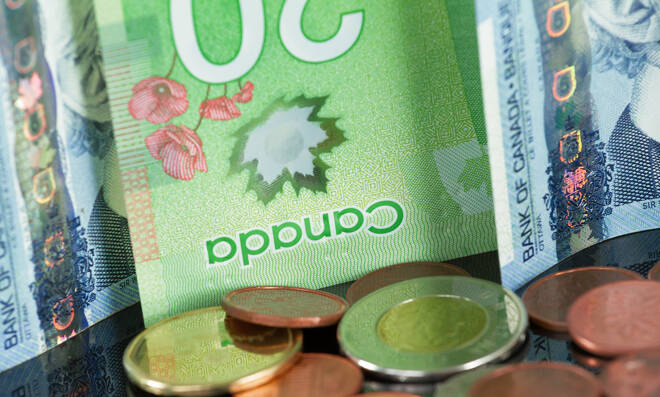Advertisement
Advertisement
USD/CAD: Loonie Pares Losses After Hitting 10-Week Low on Strong Domestic Jobs Data
By:
“The CAD traded in defensive mode through most of the week as fears over the spread of the omicron variant roiled global markets and dealt a sharp blow to crude oil prices,” noted Shaun Osborne, Chief FX Strategist at Scotiabank.
The Canadian dollar managed to pare losses after hitting a 10-week low against its U.S. counterpart on Friday as a recovery in crude oil prices and stronger domestic employment data supported the commodity currency.
“The CAD traded in defensive mode through most of the week as fears over the spread of the omicron variant roiled global markets and dealt a sharp blow to crude oil prices. The new, seemingly more contagious, variant that was discovered in South Africa has been found in most major countries around the world and threatens the reimposition of some virus containment measures and a loss of household confidence,” noted Shaun Osborne, Chief FX Strategist at Scotiabank.
“Very early indications suggest its symptoms are milder but markets are awaiting definitive proof on the risks its poses before attempting a significant reversal. The S&P500 is ending the week about 1% lower versus last Friday after experiencing its worst two-day rout since October 2020.”
Today, the USD/CAD pair rose to 1.2846 up from Thursday’s close of 1.2808. The Canadian dollar hit its lowest level in over two months last week. After gaining about 2.3% in October, the Canadian dollar weakened over 3.1% last month.
According to Statistics Canada, the Canadian economy added 153,700 jobs in November, much higher than the analysts’ expectations of 35,000. As a result, the unemployment rate decreased to 6.0%, better than the consensus estimate of 6.6%.
“At writing, USDCAD has seemingly avoided (or is attempting to, at least) a close for the week above 1.28 owing to Canada’s strong jobs report. This has offset the strength in the USD after US household survey data showed a strong increase in jobs and improvement in the employment/population ratio—notwithstanding a disappointing nonfarm payrolls print,” Scotiabank’s Osborne added.
“Technically, USDCAD remains in an ascending trajectory that is targeting a test of 1.29 once the mid 1.28s zone breaks, but USD overbought conditions remain a near-term impediment for further dollar gains toward 1.30 so it may see a consolidation period around current levels. Support is 1.2750 followed by 1.2720/30 and the figure zone; additional declines face support every half-cent mark or so.”
On the other hand, the dollar index, which measures the value of the dollar against six foreign currencies, was trading nearly flat at 96.157. The Invesco DB US Dollar Index Bullish Fund, which is designed for investors who want a cost-effective and convenient way to track the value of the U.S. dollar relative to a basket of the six major world currencies – the euro, Japanese yen, British pound, Canadian dollar, Swedish krona and Swiss franc – traded -0.2% lower at 25.77 on Friday.
Last week, minutes of the U.S. Federal Reserve meeting confirmed market expectations that the Fed will raise rates sooner than other major central banks. The greenback rose to 16-month highs against most other major currencies because of the hottest U.S. inflation reading in a generation that pushed investors to bet that interest rates are likely to rise sooner than previously thought.
On the other hand, according to the Labor Department, U.S. non-farm payrolls rose by 210,000 jobs last month, missing analysts expectations of 550,000 jobs. In addition, the unemployment rate fell to 4.2% from 4.6%, the lowest since February 2020.
However, it is highly likely that the world’s dominant reserve currency, the USD, will rise by end of the year, largely due to the expectation of at least one rate hike next year. With the dollar strengthening and a possibility that the Federal Reserve will raise interest rates earlier than expected, the USD/CAD pair may experience a rise.
Canada is the world’s fourth-largest exporter of oil, which edged higher after OPEC+ said it could review its policy to hike output if demand weakens due to Omicron. Oil prices hit over three-month low on Tuesday after Moderna’s chief questioned the effectiveness of COVID-19 vaccines against the Omicron, which shook the markets and raised concerns about oil demand, Reuters reported.
At the time of writing, U.S. West Texas Intermediate (WTI) crude was trading 0.12% higher at $66.58 a barrel. Higher oil prices lead to higher U.S. dollar earnings for Canadian exporters, resulting in an increased value of the loonie.
“The 3 Commodity units (AUD, NZD and CAD) now appear vulnerable on 2 fronts – (1) as risk currencies trading in a risk-off environment created by the new Covid strain; and (2) the 3 units having one of the more aggressive central bank rate hike profiles discounted by markets. Against USD though, the 3 units could find better support (as USD is probably even more vulnerable to the removal of the more aggressive Fed rates pricing),” noted analysts at Citi.
About the Author
Vivek Kumarauthor
Vivek has over five years of experience in working for the financial market as a strategist and economist.
Advertisement
